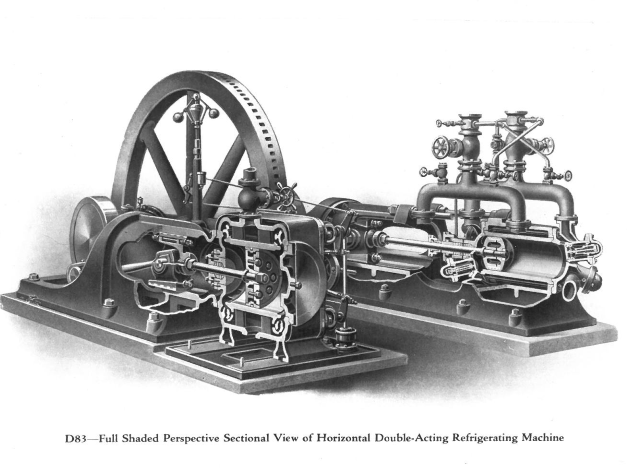Kiefer Pears; old fashioned Hubbard and other large winter squash; salt; pickling; smoked meats...
- Tracing the History of New England’s Ice Trade
Devin Hahn & Amy Laskowski | February 4, 2022 | Boston University
Posted on 08/10/2025 7:25:37 PM PDT by kawhill
Violet, 5, wants to know: what was life like before refrigerators? And Ellinor, 6, asks: how did they make ice in the old times? In this episode, we learn about the history of ice harvesting and the industry that built up around it, where ice cut from lakes in New England was shipped to as far away as India and the Caribbean.
(Excerpt) Read more at vermontpublic.org ...
Iceboxes, root cellars or spring houses built near cool running water.
My grandparents lived just west of Valley Forge. They had a cellar under an old smokehouse. They would cut ice from the Schuylkill River in winter and stash it in straw in that cellar, and the ice would keep well into the summer.
This film covers it at about the 6:23 mark. https://www.youtube.com/watch?v=Ti5bo3OxZ2c
Kiefer Pears; old fashioned Hubbard and other large winter squash; salt; pickling; smoked meats...
My brother lives in a house built on British territory, in the US, in the very early 1700s. It came with (he hasn’t lived there that entire time) a 15’ deep, 400 sq ft stone-lined pit. Before electricity, they would harvest ice off the river behind the house and deposit it in the ice pit. (This was done in the winter) So, they had year-round refrigeration.
Meat was either smoked or salted or canned.
Ice houses were all over and ice was cut in winter with ice saws-i have one.
Then the ice was stored under straw or sawdust in the ice houses.
In the cities, there were ice deliveries available.
Usually, things were delivered, like milk, and consumed before it went bad. Dinners had very little left overs and what there was, was fed to the dogs or cats, pigs, chickens, etc.
I barely remember the old ice box we had. Very little was in there.
Nothing was frozen. No such thing as a freezer.
Cellars stored a lot of things like potatoes and canned stuff. Hams, etc were stored in the smoke house.
Ice Houses, Root cellars, caves or tunnels.
For the vast majority of humankind, they were not able to keep food cold, except during winter. The old saw: Everyone gets their fair share of ice - The rich in summer, the poor in winter. Meat was eaten fresh, or cured in some manner - salt, smoke, jerky, etc. Produce was eaten in season, or canned. No fresh raspberries in January from Chile.
2 stories both involving my dad who was born in VERY rural Tennessee in 1937. Just down the street from the log cabin that he was born in, was a small store. This store was built OVER a natural spring. And the store had a trapdoor to a small area that they stored milk and other perishable items in the water stream. This kept them from spoiling as the water from this spring was ALWAYS cold. As in “brain freeze” if you drank it too fast on a hot day kinda cold.
At the ripe old age of 15 when my step-grandfather abandoned my grandmother, my dad quit school and got a job delivering ice blocks to people who had “ice boxes”.
The "Death Valley Days" episode titled "California's First Ice Man" (Season 4, Episode 7, aired December 12, 1955) depicts the story of Peter Jeffries, who arrives in Sacramento during the California Gold Rush era to revive his family's fortune. He discovers that Phineas Colby has financially monopolized the town. While courting Laura Colby, Peter realizes that ice, not gold, could be the key to his success.
The episode portrays his efforts to establish a business transporting ice from the mountains to the city, overcoming skepticism and logistical challenges. This venture proves successful, opening new opportunities for pioneers and shaping California's history. The story highlights the ingenuity of early entrepreneurs in the ice trade, reflecting the historical context of ice being shipped to California in the 1850s for preservation and cooling needs.
A great uncle, who was born in 1878 (died in 1976), talked about having ice all through the summer from a local ice house. I saw a picture of the building in his local historical society. Looks like quite solid construction. I looked like some sort of straw was the insulating material.
As a side note, this uncle and his brother had jobs as 10-12 year old kids, delivering dynamite in their family wagon, to local farmers (for rock/tree stump removal) from the local Dupont factory/warehouse.

Let's include the California Cooler pantry.
https://www.thekitchn.com/old-school-wisdom-the-californ-143568
My GGM cooled food in a nearby stream.
Those Periscope Films are true treasures. :)
Mom called the refrigerator the Ice Box, so us 7 kids did too.
We have a root cellar and an inground cement springhouse with a trough along the wall full of cold flowing groundwater where we kept the full milk cans prior to trucking. When we stopped using milk cans it kept our beer cold.
We used to joke that you sobered up every time you reached down in the cold water to grab another beer.
Same here—except I was an “only child”.
And they used other food preservation methods to store their food.
Disclaimer: Opinions posted on Free Republic are those of the individual posters and do not necessarily represent the opinion of Free Republic or its management. All materials posted herein are protected by copyright law and the exemption for fair use of copyrighted works.